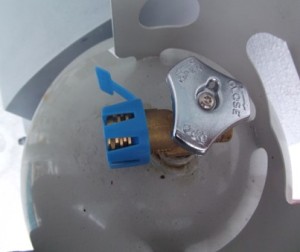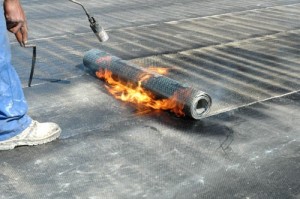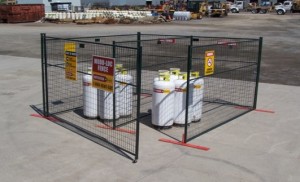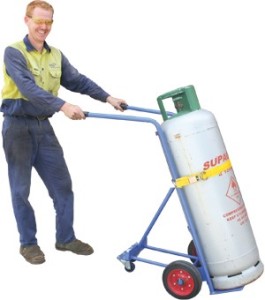This article, related to the impact of propane regulatory changes to lessors of construction heating equipment, was initially prepared for distribution at the Ontario Chapter of the Canadian Rental Association’s 2015 annual meeting and trade show.
Introduction
Over the past several months, the Fuels Learning Centre has been pleased to provide information pertaining to changes to the regulations affecting the use of construction heaters and cylinder storage at construction sites. This information was printed in three recent Canadian Rental Association (CRA) Ontario newsletters. This article provides a summary of the propane regulatory changes that have been amended, added and deleted in the CAN/CSA B149.2 Propane Storage and Handling Code that affect the use and storage of propane cylinders and equipment at construction sites and industrial storage.
In 2015, the Canadian Standards Association (CSA) will issue new versions of the B149 Codes scheduled for release by CSA in August 2015. The 2015 Codes are meant to replace the current 2010 Codes in use. For the propane construction site user, it can be a challenge to determine what has been deleted, added or amended, since the last Code was published.
The 2015 editions of the Code is the completion of a 5-year code cycle that CSA uses to keep the Codes updated to address new technologies, new installation materials, and changing building environments.
Training Requirements
Provincial Regulations require the lessor of a construction heater to ensure that the lessee is instructed in the safe installation and use of the construction heater and its components and that persons who install propane cylinders and propane fired construction heaters and torches hold a recognized Record of Training (ROT) for the purpose.
This does create some issues as the current Record of Training (ROT) retraining requirements are once every 3 years, which means that people can actually be working in the field for up to 3 years before they are trained on the new regulatory requirements.
Given that 2015 is the year for the issuance of new codes it may be advisable for employers in certain segments of the industry such as gas technicians, propane tank truck and cargo liner drivers, cylinder truck operators and construction site operators, to have their employees trained on the new requirements rather than wait until such time that the person’s ROT is up for renewal.
The adoption of the 2015 Code is done by each province and territory separately with some Authorities Having Jurisdiction (AHJ) adopting the Codes immediately and others taking several years. A person must use the most current Code adopted in their Province or Territory for new or upgrading propane installations. In addition, each Province or Territory can, when adopting the Codes add, amend or delete clauses from the Code by way of their Code Adoption Document (CAD).
Ontario Adopts Portions of 2015 Code
 The Technical Standards & Safety Authority (TSSA) issued an amendment to their Propane Code Adoption Document which is effective October 1, 2014. TSSA felt that new requirements in the 2015 version of the Code were considered important to be implemented in Ontario right away and addresses gaps in the current Code to enhance safety. In particular, the new requirements pertaining to cylinder use and storage at construction sites became effective as of October 1, 2014.
The Technical Standards & Safety Authority (TSSA) issued an amendment to their Propane Code Adoption Document which is effective October 1, 2014. TSSA felt that new requirements in the 2015 version of the Code were considered important to be implemented in Ontario right away and addresses gaps in the current Code to enhance safety. In particular, the new requirements pertaining to cylinder use and storage at construction sites became effective as of October 1, 2014.
Once the Codes and Standards are adopted there will be an immediate training need for persons who perform work that is regulated by these documents. In Ontario, this was October 1, 2014, which means training programs must reflect the latest regulatory requirements as of October 1, 2014, for Ontario and in other provinces later in 2015. Construction heater lessors should ensure their training providers have updated their programs to reflect the new requirements. The Fuels Learning Centre currently offers three programs related to the safe installation and operation of construction heaters and torches reflecting all the new regulatory requirements.
If training is required on both construction heaters and torches, then AV01 is the correct course to take. If training is required only for construction heaters, then AV02 is the correct course while AV03 focuses on hand-held torches only.
New Definitions and Clauses
Construction Site
The new term defines a Construction Site as “a temporary worksite involving construction activities such as the erection, alteration, and dismantling or demolition of a building or equipment, re-roofing of a building, or digging”. The term was added to identify that the handling of cylinders and propane apparatus in use or in storage at construction sites are subject to significantly differing situations.
Propane Cylinder Installation
Clause 5.10 originally restricted cylinders from being installed under any fire escape, stairway, or ramp used as a means of egress from a building. The clause has been amended to read “container” so the restriction now applies to both cylinders and tanks.
Connected for Use
Means a propane container that is properly connected to an approved appliance in accordance with the provisions of this code. The rationale behind adding this new term relates to disputes which have occurred in the field over whether or not cylinders that are properly connected to an appliance that is not running, and which may or may not be turned on for use, are in storage and therefore subject to the requirements for storing cylinders. Properly connected cylinders that remain connected for use, intermittent use, or future use, should not be subject to storage requirements.
New Clause 6.1.16
Cylinders in storage or connected for use, cylinder-regulating equipment, or a cylinder manifold, shall not be exposed to temperatures in excess of 125 degrees Fahrenheit or 50 degrees Celsius. This clause was added to limit the temperatures to which propane cylinders, regulating equipment or cylinder manifolds can be exposed.
Use of OPDs
 Clause 6.1.2 was amended to harmonize with US requirements. NFPA 58-2008 states that cylinders with 4 lb. (1.8 kg) through 40 lb. (18 kg) propane capacity for vapour service shall be equipped or fitted with a listed overfill protection device; the current Canadian requirement starts at zero, not 4 lbs. (1.8 kg) as in the US. The Clause now states that except for (a) cylinders used in industrial truck service; and (b) cylinders identified and used for industrial welding and cutting gases, refillable vapour service cylinders manufactured after January 1, 2008 with a capacity of 4 lbs (1.8 kg) through 40 lb (18.2 kg shall be equipped with an overfill prevention device (OPD) in compliance with UL 2227.
Clause 6.1.2 was amended to harmonize with US requirements. NFPA 58-2008 states that cylinders with 4 lb. (1.8 kg) through 40 lb. (18 kg) propane capacity for vapour service shall be equipped or fitted with a listed overfill protection device; the current Canadian requirement starts at zero, not 4 lbs. (1.8 kg) as in the US. The Clause now states that except for (a) cylinders used in industrial truck service; and (b) cylinders identified and used for industrial welding and cutting gases, refillable vapour service cylinders manufactured after January 1, 2008 with a capacity of 4 lbs (1.8 kg) through 40 lb (18.2 kg shall be equipped with an overfill prevention device (OPD) in compliance with UL 2227.
 Operators of propane torches must be aware of this requirement to ensure the cylinders to which they are connecting hand-held torches are equipped with an OPD valve unless the cylinder was manufactured before 2008. It’s important to note that when cylinders are requalified, an OPD valve will be installed, therefore, the only cylinders that may not have an OPD valve were those manufactured between November 2004 and January 2008.
Operators of propane torches must be aware of this requirement to ensure the cylinders to which they are connecting hand-held torches are equipped with an OPD valve unless the cylinder was manufactured before 2008. It’s important to note that when cylinders are requalified, an OPD valve will be installed, therefore, the only cylinders that may not have an OPD valve were those manufactured between November 2004 and January 2008.
Cylinder Requalification
Propane cylinders must be visually inspected and requalified once every 10 years starting with the date of manufacture. Clause 6.1.5 has been amended to remove the previous requirements for the 10-year cylinder inspection and requalification from the Code. The clause now states that refillable cylinders shall not be refilled if they are due for requalification as prescribed by requirements of the CSA Standard B339 Cylinders, Spheres & Tubes for the Transportation of Dangerous Goods.
Users of propane cylinders at the construction site should be aware that a cylinder cannot be refilled if the requalification is past-due.
Single-trip Type Propane Cylinders
Clause 6.4.5 has been amended to clarify that Specification TC-39M and aerosol containers cannot be refilled. In addition, Clause 6.5.1.4, which deals with the number of aerosol containers and TC-39 non-refillable cylinders which may be stored in a dwelling, was amended for correctness.
Single-trip small capacity propane cylinders are often used on the construction site and the site manager should be aware of the storage requirements and that these cylinders cannot be refilled.
Addition to Scope
The scope of the Code has been amended to include maintenance as a requirement for containers and equipment to be used for propane at customer locations, in distribution locations, and filling plants.
The rationale for this change was that regardless of who owns the propane storage container, be it the propane distributor or customer, the container must be properly maintained. Safety requirements for systems and components should not be different for various owners.
Increase in Cylinder Size at Exchange Locations
The Code was amended to delete the 20 lb. maximum cylinder size that may be stored at a cylinder exchange. The rationale provided is that due to a demand from RV customers, 30 lb. cylinders are being offered at exchange locations. The safety concerns of 30 lb. cylinders are not different from those of 20 lb. cylinders. Maintaining the cabinet maximum capacity of 500 lb. (25 x 20 lb., or 16 x 30 lb., or combination thereof) maintains the same risk and requirements of a single full exchange cabinet.
Cylinder Storage Cages
To reflect current acceptable practices and to provide clear minimum design criteria that allow innovation, Clause 6.5.1.15 has been amended so that when cylinders are enclosed in a cabinet, cage, or other means not covered under clause 6.5.2.7 or 6.5.10, the confinement means shall:
- be supplied with a top cover;
- be made of noncombustible material and be structurally sound with no openings greater than 4 square inches (25.8 cm²);
- have at least two sides constructed to provide equal ventilation through openings at the top and bottom of the side providing, as a minimum, the equivalent total opening of 15% open area on each side panel;
- not restrict the dispersion of any fuel gas leak to ensure it is well ventilated;
- have its base on a firm level footing in an upright position; and,
- not be located against other objects, or have objects attached that restrict ventilation.
Storage of Cylinders & Sources of Ignition
To clarify requirements for storing cylinders Clause 6.5.1.5 has been amended to require that any cylinder in storage shall not be exposed to an open flame or other sources of ignition, and shall be protected from tampering or damage by fencing or equivalent means.
Cylinders Stored at Construction Sites
Clause 6.5.3.1.2 has been amended to clarify the storage requirements, the clause indicates that a stored cylinder shall be located in an area that complies with the requirements of 6.5.3.2., and the storage area shall be outdoors.
- When the conditions of this clause are met, a storage area utilizing a structure with overhead protection, walls, or both, meets the intent of outdoor storage.
- The structure is designed to be enclosed by no more than two solid walls on the level the cylinder(s) are stored;
- The cylinders are located within 25 ft. (7.6 m) of an open area of the perimeter opening;
- When a wall of the structure is a part a building, that building must be under construction, repair, improvement, and there must be no inhabited dwelling units or inhabited sections of that building;
- There are no openings through which gas may travel to a lower elevation, such as an open stairway on the floor on which the cylinders are located; and
- There are no wall openings through which gasses could travel into another structure or building.
- Cylinders may be stored in a cabinet that meets clause 6.5.2.4, in the storage area.
- A storage area may be on a roof of a structure or building provided the conditions of clause 6.5.3.9 are met.

Portable fencing used to house stored propane cylinders at a construction site.
These amendments clarify acceptable “outdoor” storage by identifying proper and safe storage options that reflect conditions on construction sites, and is based on the hazards (gas accumulation, vehicular traffic, hoisting, etc.), rather than focusing on the location alone.
Presently, rules from various parts of the Standard that were not intended to address construction activities are being referenced to regulate construction activities. Even with changes to the 2010 version, it is a struggle to understand which sections of the B149.2 are likely to be applied on construction sites by an inspector.
The result is confusion for workers and trainers on what constitutes compliance, inconsistency in enforcement, and disagreement on the job site over safety.
Clause 6.5.3.2 has also been amended to clarify storage of propane cylinders at construction sites and requires that cylinders in storage shall;
- be stored in an area that:
- provides protection from tampering;
- is free from vehicular or mobile equipment travel, or protected by barriers or the equivalent;
- has “NO SMOKING” signs which are prominently displayed. These signs shall be in accordance with Clause 7.12.3; and
- meets the requirements of table 6.3.
- be placed such that the relief valve on any cylinder is not less than 3 ft. (1m) horizontally from any building opening that is below the level of the relief valve discharge;
- be placed such that the relief valve discharge is not less than 10 ft. (3 m) on the horizontal plane from the air intake of any appliance or air-moving equipment;
- be stored in an area that meets clause 6.5.1 and 6.5.3.9.
The rationale behind these amendments is that construction sites occur under a variety of wide-ranging circumstances. Storage requirements that are intended for industrial settings are too limiting and expose cylinders to hazards associated with construction activities. Cylinder storage on construction sites requires reasonable objectives which also address the worksite hazards.
Movement of Propane Cylinders
Clause 6.5.3.8 has been amended to address the movement of propane cylinders around the construction site and indicates that moving a propane cylinder from one level to another level or the roof of a building may be done using:
- a freight, service elevator, or construction hoist; or,
- if by public passenger elevator or escalator, only the person(s) involved with the cylinder shall be in the elevator or on the escalator.
 When moving a propane cylinder to or from the roof or one level to another of a building, each cylinder valve outlet shall be closed, plugged and the valve protective cap or collar in place.
When moving a propane cylinder to or from the roof or one level to another of a building, each cylinder valve outlet shall be closed, plugged and the valve protective cap or collar in place.
Storage of Propane Cylinders on Roofs
New clause 6.5.1.14 permits propane cylinders to be stored on roofs. Cylinders to be stored on roofs must meet certain conditions. The clause directs the reader to a specific clause 6.5.3.9 that details the conditions under which a cylinder may be stored on the roof of a structure under construction. The Clause indicates that a cylinder which contains propane liquid or vapour shall not be stored on the roof of a building unless it is stored in accordance with clause 6.5.3.9, or connected for use in accordance with clause 6.8.
New clause 6.5.3.9 – Cylinders on Building Rooftops states that cylinders on building rooftops shall comply with the following:
- A propane cylinder shall not be on the roof of a building unless the cylinder is to be connected for work undertaken on the roof during the current or the immediately following work shift.
- Cylinders not in use shall be stored in accordance with provisions of clause 6.5.3.2 and the following shall additionally be met:
- the cylinder(s) weight shall not exceed the net load capacity of the roofing structure as specified by the building owner or management;
- the storage area shall be at least 10 ft. (3m) from the building edge or a change in elevation of more than 3 feet (1m);
- cylinders shall be secured to maintain the cylinder in its proper storage position during inclement weather; and
- all cylinders shall be removed upon completion of the work.
- Cylinders properly connected in an approved manner to the appliance it serves shall be adequately secured from inclement weather.
- No more than 1,000 lb. (450 kg) of propane in total capacity shall be stored on the roof.
These amendments provide the following benefits.
- Retains the original intent of the 2000 change regarding cylinder storage on rooftops for permanent appliance installations – limiting rooftop cylinder storage on permanent installations.
- Provides clear guidance around cylinder use and storage on rooftops for roofers.
- Provides for storage of cylinders on the roof to reduce the number of times cylinders are hoisted, lowered, and manhandled, and the hazards associated with moving cylinders, and to address storage security.
- Limits roof top storage to a practical number of cylinders.
- Adds additional protection for firefighters with a new requirement to post signs at occupied buildings.
View PDF










